0 Introduction
Several countries including Republic of Korea have been considered for power system interconnection between NEA (North-East Asian) countries since 2000 [1-14].However,it has not been developed owing to various political and economic obstacles between neighboring countries.The Korean government has declared to achieve carbon neutrality (net-carbon emission zero) by 2050 and realize the national policy,which is necessary to reduce domestic carbon emission and process CO2 emission from neighboring countries.
The reduction of carbon emission and achieving carbon neutrality policy to preserve the global environment based on the Paris Agreement has become a mandatory trend worldwide.Each country is required to attain specific reduction targets and devise methodologies,and it should be reported to the Conference of the Parties (COP).
Generally,the carbon emission reduction plan should be established by various domestic and international means considering the environment of each country.Korea has planned to reduce its carbon emissions by 33.5 MtCO2eq(million tons of CO2 equivalent) by mobilizing foreign means by 2030.Hence,this study describes the achievement of the carbon emission target based on this point of view using power interconnection projects by importing ecofriendly renewable energy through the Northeast Asian power grid.Additionally,KERI has published a few studies for power system interconnection (PSI) scenarios in terms of technical and economic pre-feasibility study results.Therefore,this study describes the contributions for the Paris agreement and carbon neutrality through permissible power system interconnection scenarios among neighboring countries according to the perspective of Korea.This is based on the national basic plan of power demand and supply.Additionally,this study discusses the import/export potentials for green energy trading between NEA countries and the obstacles that should be overcome to promote the energy interconnection projects in marketable and energy security standpoints.
1 Carbon neutrality policy and power supply plan
According to the 9th basic plan for power supply and demand in Korea,the power demand is projected to annually increase by 1% from 89.1 GW in 2020 to 102.5 GW in 2034 [15].The installed generation capacity is expected to increase from 120.5 GW in 2020 to 185.3 GW in 2034 in response to the power demand.The power demand is expected to increase only by 13.4 GW during this period,while the installed capacity is projected to significantly increase by 64.8 GW.The utilization of renewable energy,which has a relatively low capacity factor,should significantly increase to reduce carbon emissions owing to the carbon neutrality policy.Although the establishment of nuclear (23.3→19.4 GW) and coal power plants (35.8→29.0 GW) is expected to slightly decrease,the utilization of renewable energy (35.8→29.0 GW) is expected to significantly increase.Additionally,the utilization of LNG(20.1→77.8 GW) is expected to gradually increase and subsequently decrease.On the supply side,it could be explained the reduction of coal and nuclear power plants and renewable plants expansion.The development of LNG plants is expected to increase to ensure stable power supply during the interim stage.The quantity of LNG required will be comprehensively finalized in the future.
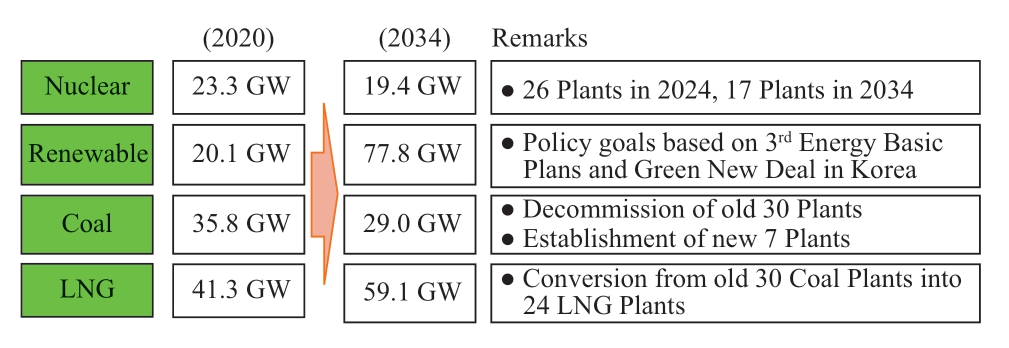
Fig.1 Generation power mix scenarios [15]
The power mix in 2030 consists of reducing coal power generation,expanding renewable energy power generation,and utilizing additional carbon-free power sources (ammonia power generation).The required power generation in 2030 is estimated to be 612.4 TWh considering the transmission and distribution power loss rates.Additionally,the power generation quantity of renewable energy is projected to significantly increase by 185.2 TWh in 2030.This value has been obtained from a recent draft by the Carbon Neutrality Committee,and it is a considerably eco-friendlier and aggressive target than that of the existing 9th basic plan for power supply and demand.However,it might be slightly changed owing to the reinforcement of nuclear policy.
The Carbon Neutrality Committee in Korea recently upgraded the 2030 National Determined Contribution(NDC),which was submitted to the United Nations at the end of 2020 [10].The previous target ensured a reduction of 26.3% (net-emissions 536 MtCO2eq including offset by forest sinks) compared to that of the total emissions (727 MtCO2eq) in 2018.However,the revised target ensures a reduction of 40% compared to that of the total emissions of 2018.Hence,the total net-emissions in 2030 are expected to be 436 and 100 MtCO2eq less than that of the previous target (536 MtCO2eq) [16-17].
This is an international commitment to the 2030 carbon emissions that Korea should comply with based on the 2015 Paris Agreement.This content can be changed only in the direction of strengthening in the future.This carbon emission reduction can be achieved by utilizing domestic and international resources.Korea has vowed to significantly decrease its domestic carbon emissions,and the in-sufficient parts can be procured from overseas.The Korean government is planning to procure a reduction of 33.5 MtCO2eq from foreign countries.
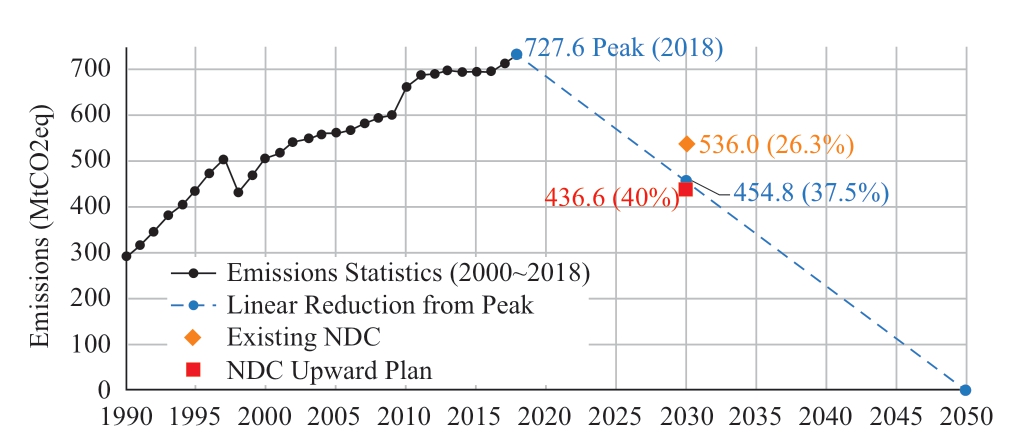
Fig.2 Carbon emission reduction plan in Korea [16]
A crucial area for carbon emission reduction is the energy transition sector.The energy transition sector presently accounts for 37% of the total carbon emissions in Korea,and it is expected to increase owing to the social trend of electrification.The energy conversion sector is a core sector of carbon neutrality,and it is challenging to achieve 120 MtCO2eq from 270 MtCO2eq in 2018 to 150 MtCO2eq in 2030.A power system interconnection between NEA poses as an exceptional solution to reduce carbon emissions considering energy transition and the overseas sector.This solution highlights the necessity of power interconnection utilizing renewable energy resources in the NEA region
2 Interconnection scenarios
The Korean power system has been operational since 1949 with an island status after terminating its power supply from DPRK.The Republic of Korea is examining the power system interconnection with neighboring countries to overcome this power island situation along with the realization of 2050 carbon neutrality.In particular,several alternatives are available to achieve power interconnection with DPRK,Russia,China,and Japan.In this regard,multiple studies have been conducted since 2000 in Northeast Asia and related reports have been published.These reports investigated the feasibility of power system interconnection among NEA regions in terms of technical,economic,and marketable points.Additionally,these reports highlighted a few difficulties such as political obstacles and financial problems.These issues should be solved with bilateral or multi-lateral basis.The NEAREST project conducted by KERI and ESI in Russia was the first report [1].
NEA-CBT reports since 2000 (Multilateral PSI)
· NEAREST (KERI and ESI 2003) [1,6]
· Asian Super Grid (JREF 2011) [3]
· GOBITEC (ECS 2014) [18-19]
· Northeast Asia Supergrid [5]
(KEPCO,KEEI with Skoltech,2014)
· GRENATEC (HRENATEC 2015) [20-21]
· Asia Pacific Power Grid (Japan Policy Council 2011)
Bilateral PSI Scenarios
· Korea-China,Korea-Japan,Korea-Russia,and Korea-DPRK in Korea perspectives
· China-Russia,Russia-Japan…
The following figure is an example that depicts the overall picture for the NEA power interconnection.KEPCO has reviewed the possibility of power system interconnection with China,Japan,and Russia as utility level since 2010.
3 Carbon neutrality and power imports
According to the 9th basic plan for power supply and demand in Korea,the peak demand is expected to be 102.5 GW in 2034.
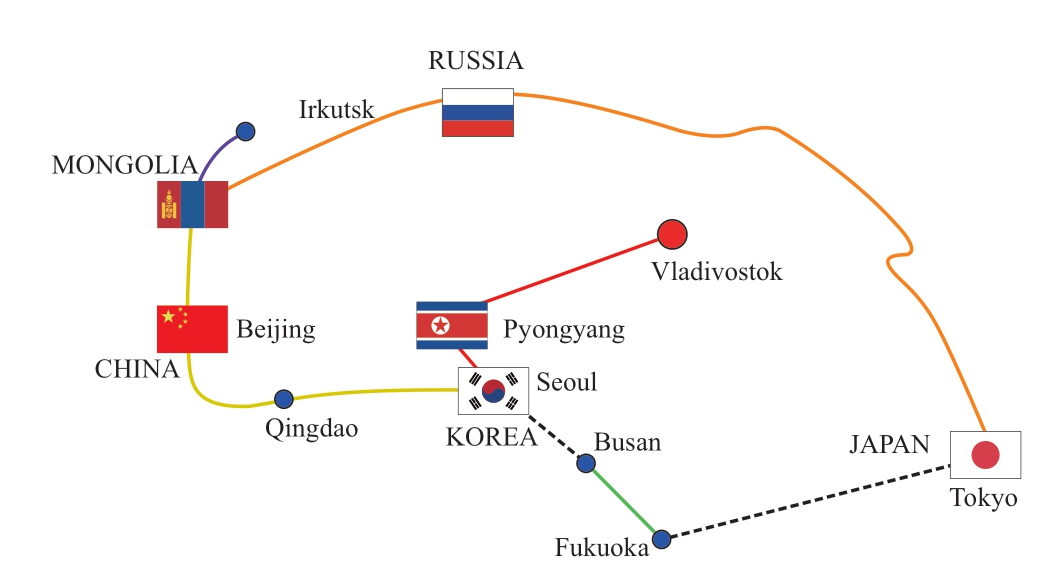
Fig.3 Concept of multilateral PSI in NEA
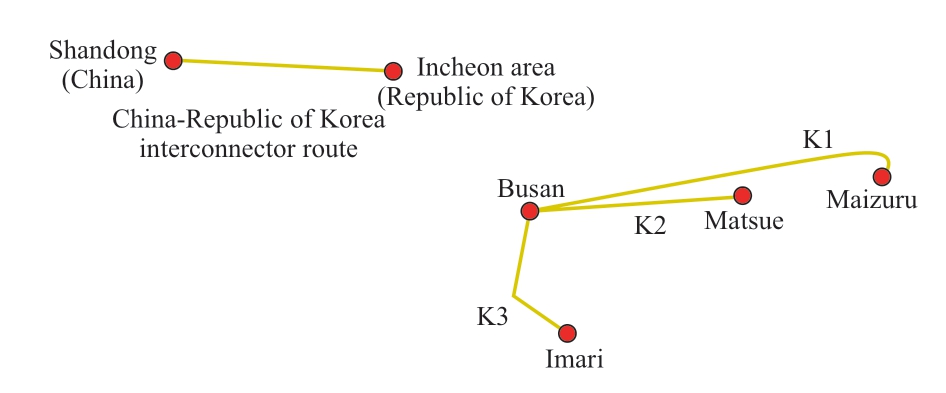
Fig.4 Interconnection scenario between KR/CH/JP
The maximum capacity for international power trading,considering energy security,should be less than 5% of the peak demand.Normal energy supply might not be possible in special cases if it exceeds 5% due to political or technical problems between power trading countries.A problem in the stability of the power supply might result in a socioeconomic disaster,and the adverse effects of power loss between cross-border interconnected transmission line will be extensive.Therefore,the 5% rule of international trading power should be followed.The permissible importing capacity of Korea from neighboring countries under these circumstances is estimated to be less than 5 GW in 2030.Blackouts in power system will have enormous socioeconomic effects as mentioned above.In general,the power supply cost increases if generation resources are diversified,and power supply reliability will be improved.In the case of multiple power resources,the remaining sources can be normally operated in the event of failure of a power source.This concept can be applied to the cross-border interconnected power system.The dependence upon only one interconnected line is perilous from the energy security perspective.Hence,the maximum importing capacity from one country should be limited to 3 GW or lower in the case of Korea.
The economic assessment of specific power interconnection model is based on the net present value of total costs and benefits for the entire life-cycle of the analysis target.The analysis model initially calculates the total benefit and cost of power system interconnection,and subsequently calculates the present value of net benefit (=gross benefit-gross cost).The input parameters are obtained considering the characteristics of specific interconnection model.For instance,the analysis model and typical factors of benefits and costs is described in equation(1) and Fig.5.Furthermore,the CO2 tax reduction effect should be considered for the economic analysis of power system interconnection model.This study only describes the advantages of carbon reduction,and a detailed economic analysis is not performed.
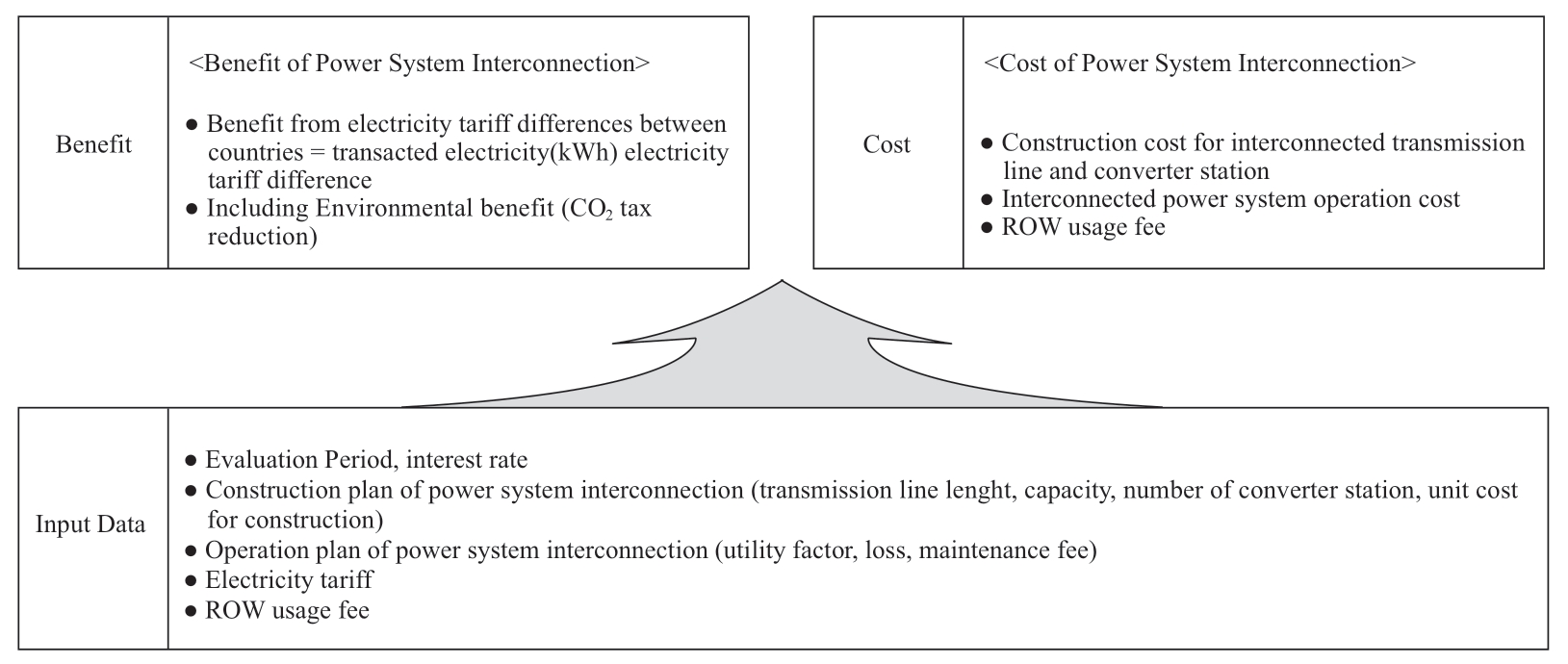
Fig.5 Factors of input data,costs,and benefits for economic analysis
Here,NPV: Net Present Value
Bt: Total Benefit in year t (Benefit)
Ct: Total Cost in year t (Cost)
r: interest rate
Approximately 14.12 million tons of CO2 emissions can be reduced if green energy is imported with a capacity factor of 80% and a capacity of 5 GW through system connection with neighboring countries.This is a remarkable achievement equivalent to 42% of the total reduction of 33.5 MtCO2eq.It has been reported that 124 overseas CO2 reduction projects of Korean companies are in progress as of October 2021,with an annual capacity of 20 MtCO2eq.Additionally,the number of partner countries for overseas projects is expected be expanded through bilateral agreements between the governments in the future.However,since a concrete realization plan is absent for alternative overseas reductions,it is a matter that should be considered in the future.The establishment of the Northeast Asian power interconnection can fulfill the overall CO2 reduction.
Presently,the unit cost of carbon emission per kWh of standard power generation in Korea is 0.403 kg CO2/kWh.The carbon emission reduction should be considered if ecofriendly renewable electricity is imported from abroad.The amount of annual power imported is expected to be 35.04 TWh if a capacity of 5 GW for base load is imported at an annual capacity factor of 80%.This can reduce carbon emissions by 14.12 MtCO2eq.The Korean government plans to reduce the carbon emissions by 33.5 million tons through overseas projects to achieve the 2030 NDC target.The carbon reduction amount of 14.12 MtCO2eq through the cross-border eco-friendly renewable energy is equivalent to 42% of the 33.5 MtCO2eq total overseas procurement.The carbon tax or price is variable in the CO2 market.If the unit price of carbon emission is assumed to be approximately$30/tCO2 considering the present carbon tax,then an annual 14.12 MtCO2eq can generate an economic benefit of$423.6M.This is the background for the feasibility of power interconnection from the point of view of Korea.Table 2 shows the amount of trading power and carbon emission reduction by interconnected capacity and capacity factor.
Table 1 Expected generation mix in 2030 (Korea)

Table 2 Carbon emission reduction by interconnected capacity and capacity factor

Table 3 Execution directions by phase
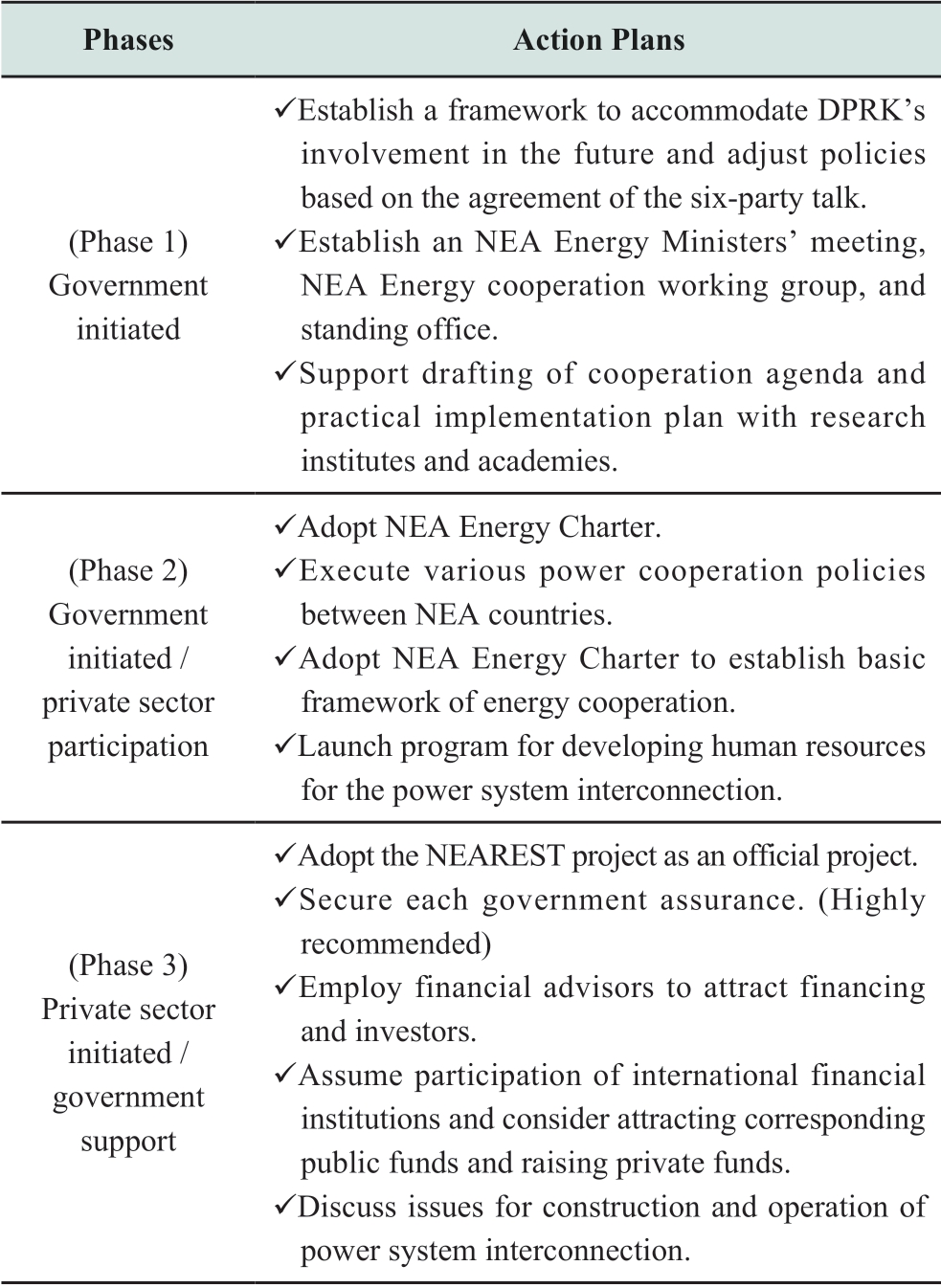
4 Factors affecting the NEAREST scenarios and execution directions by phase
Technical,economic,and marketable disparity are the factors that should be considered while developing the NEAREST scenarios.The power systems of the six NEA countries employ substantially different technical standards such as frequency,voltage class,system reliability and operation method,power industry structure,and industrial restructuring progress.These technical and economical differences should be considered while drafting a range of NEAREST scenarios.
The objective of critical target of power system interconnection is to reinforce the supply reliability,economic benefit,and regional cooperation based on renewable resource development.In general,cross-border power interconnection might affect several power industry issues.Cross-border power interconnection is co-related to the energy deregulation,supply reliability,economic efficiency,and change in power mix due to the CO2 emission reduction.It has positive and negative factors as described in Fig.6 [6].Comprehensively,this provides net additional positive effects.

Fig.6 PSI and related issues
The policy target of NEAREST includes: (1)Establishing a peaceful,eco-friendly,and prosperous NEA partnership through power cooperation and enhancing peaceful environment among countries (2) Raising competitiveness in power supply/demand and establishing the basis of power cooperation between the NEA countries.A leadership in the NEAREST project can be attained by initiating and leading meetings between NEA Energy Ministers to achieve the abovementioned targets.Subsequently,the Republic of Korea or a different country can propose establishing an NEA Energy Cooperation Council during the NEA Energy Ministers’ meeting to discuss the power system interconnection project and start on a joint pre-feasibility assessment.The project can establish an independent transmission company according to the investment share of each country based on the joint research and governmental consents.The participants can jointly construct and operate the interconnected power system after the financing is available.
The government level policy plan on NEAREST has three phases: 1) Development and adjustments of policy,2)Establishment of law/regulation framework,and 3) Project implementation and investment invitation.Phase 1 involves building a foundation for NEAREST with government initiation and obtains consents among participating countries.Phase 2 establishes law and regulation framework based on phase 1 efforts for future interconnection project launch.Phase 3 includes the execution of NEAREST as an official project.Descriptions of each phase are as follows:
(Phase 1: Government initiated) Development and adjustment of policy
This is the first phase that should establish a framework to accommodate the involvement of DPRK in the future and adjust policies based on the agreement of the six-party discussion.
This type of cooperation requires organizations such as the meeting of NEA Energy Ministers,energy cooperation working group,and standing office.The cooperation agenda in this phase involves establishing an energy development consortium,energy fund,and development company in terms of supply and the power system interconnection project in terms of demand.In addition,the above agenda should link energy support to DPRK,which had been discussed at the six-party talks.In this case,the government can support drafting of cooperation agenda and practical implementation plan with research institutes and academies.
(Phase 2: Government initiation/private sector participation) Establishment of framework for law and regulation
Phase 2 focuses on the implementation of various policies for power cooperation and programs between NEA countries.The power cooperation policies include,for instance,adoption of an NEA Energy Charter and construction of renewable power plants.Additionally,the parties should adopt an NEA Energy Charter mentioned previously to establish a basic framework of energy cooperation.Additionally,a working group comprised of experts from participating countries and conducting summit meetings can be options.The NEA Energy Charter is drafted by research institutes and academies in this phase.In addition,human resource development programs for construction and operation of HVAC and HVDC networks and interconnected power system should be separately launched.
An NEA Energy Charter Treaty for NEA energy cooperation (NEACT) can be established that is comparable with that of the Energy Charter Treaty (ECT).The main content of the treaty will include promoting NEA energy project investments,resolving international conflicts,organizing a cooperative business council,developing an energy cooperation project promotion plan,and establishing the organizational structure.NEACT can be classified into the NEA Energy Charter with political proclamation and a legally binding NEA Energy Charter Treaty.NEACT will be adopted at each phase by consent.
(Phase 3: Private sector initiation/government support)Project launching and investment attraction
NEAREST will be adopted as an official project in Phase 3.An assurance by the government is crucial in this phase.The project should employ financial advisors to attract financing and investors because participations of national/international investors are absolutely required.Furthermore,the project should assume the participation of international financial institutions and consider attracting investment of corresponding public fund and raising private funds as options.
Research institutes and academies should conduct detailed financial and economic analysis.Project leaders and financial advisors should prepare strategies such as longterm purchase agreement,project security,and government assurance to reduce business risks.Additionally,an individual should be appointed in this phase as an offtaker to conduct discussions with the government.Several issues on constructing and operating the power system interconnection should be discussed.
5 Conclusions
The national carbon neutrality policy,future basic plan for power supply/demand,and co-related power interconnection scenarios in Korea were discussed.The carbon emission reduction amount and economic benefit through the renewable energy importing using cross-border power system interconnection were investigated.The establishment of a power system interconnection among NEA countries has been discussed at the power utility level since 2010.However,it has not been realized owing to energy security and economic obstacles.The economic benefits can be increased and the carbon emissions of highenergy-consuming countries can be reduced if a pure ecofriendly energy transaction using renewable resources and the energy security aspect is fulfilled by a multilateral agreement involving the corresponding and a third party.Cross-border transmission corridors between NEA countries can be realized owing to the global promotion of carbonneutrality.The future directions and possible scenarios on power system interconnection should be investigated by integrating carbon neutrality and power system interconnection according to the perspective of Korea.
Declaration of Competing Interest
We declare that we have no conflict of interest.
References
[1]KERI (2003) 1st report for infrastructure on NEAREST project
[2]Yoon J,Park D,Kim H,et al.(2007) Possible interconnection scenarios and impacts on composite system reliability between ROK-DPRK-RF.IEEE Power Engineering Society General Meeting
[3]JREF (2016) The Asian super grid.The Asia-Pacific Journal
[4]Yoon J (2008) Pre-feasibility study results on NEAREST between the ROK,the DPRK and the RF.Journal of AEC
[5]KEPCO (2014) Technical report on the power system interconnections in Northeast Asia countries
[6]Yoon J (2004) Power System Interconnection in NEA
[7]Yoon J (2011) Feasible power exchange model between the ROK,the DPRK and Russia.IEEE Power Engineering Society General Meeting
[8]KERI (2002) Planning for prefeasibility study on power system interconnection in Northeast Asia
[9]Podkovalnikov S (2002) Power grid interconnection in Northeast Asia: perspectives from East Russia
[10]KERI (2021) Future Power System Plan in Korea
[11]Choi J,Tran T,Kang S,et al.(2014) Tie line constrained equivalent assisting generator model (TEAG) considering forced outage rates of transmission system.KIEE International Transactions on Power Engineering,June,4(2): 91-99
[12]Yoon J,Song S (2020),Future directions on power system interconnection in Korea’s perspective.Energy Systems Research,3(4)
[13]L Belyaev,S Podkovalnikov (2000) An approach to and results of effectiveness assessment of inter-tie <<RFE-DPRK-ROK>>
[14]S Podkovalnikov (2004) East Siberia and Russian far east estimated prospective export potentials
[15]MOTIE (2020) 9th basic plan for power supply and demand in Korea
[16]Carbon Neutrality Committee (2021) Carbon Neutrality Plan in Korea
[17]Korean government (2018) 3rd renewable energy plan
[18]Bahar H,Sauvage J (2013) Cross-border trade in electricity and the development of renewables-based electric power: lessons from Europe.OECD Trade and Environment Working Papers,February,OECD Publishing
[19]Energy Charter Secretariat (2014) GOBITEC and Asian super grid for renewable energies in Northeast Asia
[20]GRENATEC (2015) Electric Power Grid Interconnection
[21]World Bank (2021) Power sector reform in the developing world
Received: 26 April 2022/Accepted: 21 July/Published: 25 October 2022
 Jae Young Yoon
Jae Young Yoon
jyyoon@keri.re.kr
Sunghwan Song
karysong@keri.re.kr
2096-5117/© 2022 Global Energy Interconnection Development and Cooperation Organization.Production and hosting by Elsevier B.V.on behalf of KeAi Communications Co.,Ltd.This is an open access article under the CC BY-NC-ND license (http://creativecommons.org/licenses/by-nc-nd/4.0/).
Biographies

Jae Young Yoon received his B.S.M.S.and Ph.D degree from Busan National University in all electrical engineering at 1985,1987 and 1998 respectively.Since 1987,he has been working at Korea Electro-technology Research Institute (KERI) and at now he is an executive director.His current research interest is the power system interconnections between Northeast Asian Countries based on power system analysis.
(Editor Yanbo Wang)
